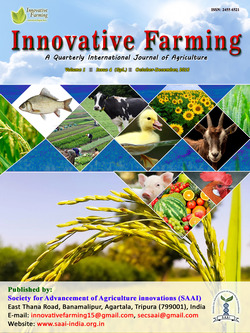
Phosphorus Microbiology under Organic Farming System
D. Dey*
Dept. of Agricultural Chemistry and Soil Science, Directorate of Research, Bidhan Chandra Krishi Viswavidyalaya, Kalyani-741235, Nadia, West Bengal, INDIA
N. Saha
Dept. of Agricultural Chemistry and Soil Science, Directorate of Research, Bidhan Chandra Krishi Viswavidyalaya, Kalyani-741235, Nadia, West Bengal, INDIA
DOI: NIL
Keywords: Organic farming, Tea Garden, Phosphate solubilization
Abstract
The problem in organic farming system is acute with nutrient element like phosphorus as it cannot be gained through biological acquisition as that of biological nitrogen fixation Microbiologically driven P-transformations are vibrant under organic farming systems A research work was conducted to study the microbiological potentiality of phosphorus transformation under organic production systems. To understand transformation of phosphorus, soils were sampled from older established certified organic tea gardens under two agro-ecological zones of Brahmaputra and Barak Valley of Assam. Soils of conventional tea gardens of those regions were also collected and treated as control to understand the edge of organic husbandry over conventional ones. A set of microbiological parameters leading to mineral phosphate solubilization including phosphate solubilizing microbial load, their solubilizing capacity, enzyme activities, mineralization rate, microbial biomass phosphorus, immobilization potential were assessed under each system. Organically managed tea gardens stimulated higher phosphate solubilizing microbial load, % of mineral phosphate solubilisation capacity reaches as high as 64% while in case of conventional tea gardens it is only 22%, more net accumulation of phosphorus and better enzyme activities leading to higher organic phosphorus mineralization in organic tea gardens.
Downloads
not found
Reference
Brookes P.C., D.S. Powlson and D.S. Jenkinson. 1984. Phosphorus in the soil microbial biomass. Soil Biology and Biochemistry, 16: 169-175.
Chen, C.R., L.M. Condron, M.R. Davis, R.R. Sherlock. 2000. Effects of plant species on microbial biomass phosphorus and phosphatase activity in a range of grassland soil. Plant and Soil, 220: 151-163.
Dalal, R.C. 1977. Soil organic phosphorus. Advances in Agronomy, 29: 83-117.
Goldstein, A.H. and S.T. Liu. 1987. Molecular cloning and regulation of a mineral phosphate solubilizing gene from Erwinia herbicola. Biotechnology, 5: 72–74.
Joshi, M., T.K. Prbhakarasetty and S. Bhaskar. 2011. In: Sustainability Through Organic Farming. Kalyani Publisher, New Delhi. Pp 87–88.
Mikanova, O. and J. Novakova. 2002. Evaluation of the P-solubilizing activity of soil, microorganisms and sensitivity to soluble phosphate. Rostlina Vyroba, 48: 397–400.
Oehl, F. 2004. Impact of long-term conventional and organic farming on the diversity of arbuscular mycorrhizal fungi. Oecologia, 138: 574–583.
Stockdale, E.A., N.H. Lampkin, M. Hovi, R. Keatinge, E.K.M. Lennartsson, D.W. Macdonald, S. Padel, F.H. Tattersall, M.S. Wolfe and C.A. Watson. 2001. Agronomic and environmental implications of organic farming systems. Advances in Agronomy, 70: 261–327.
